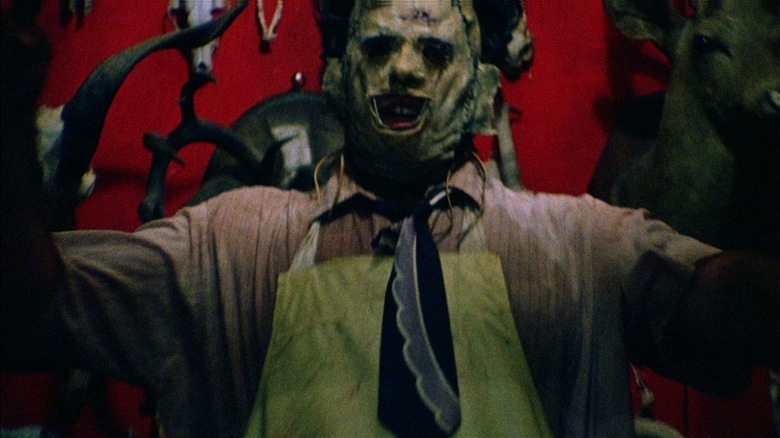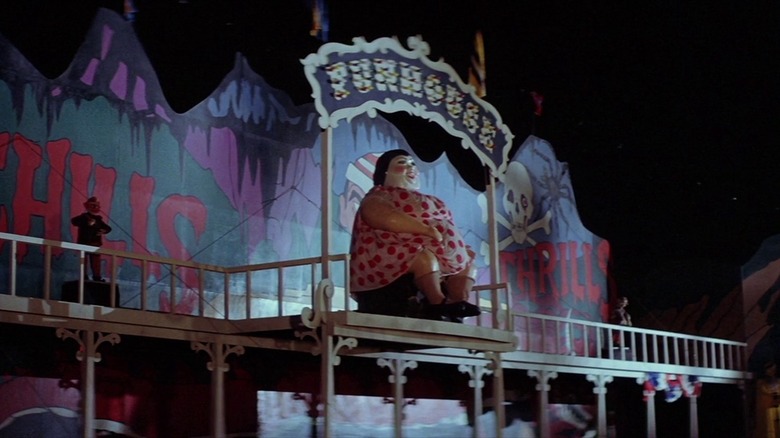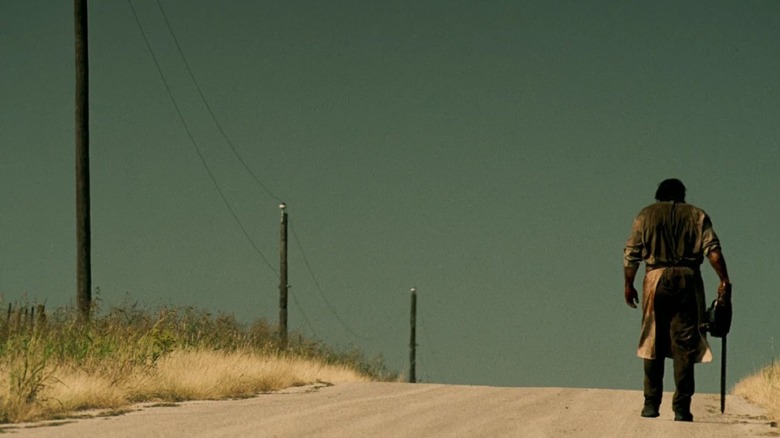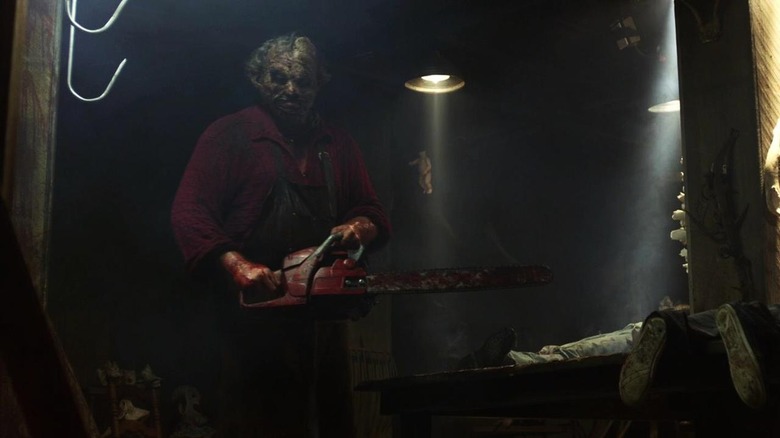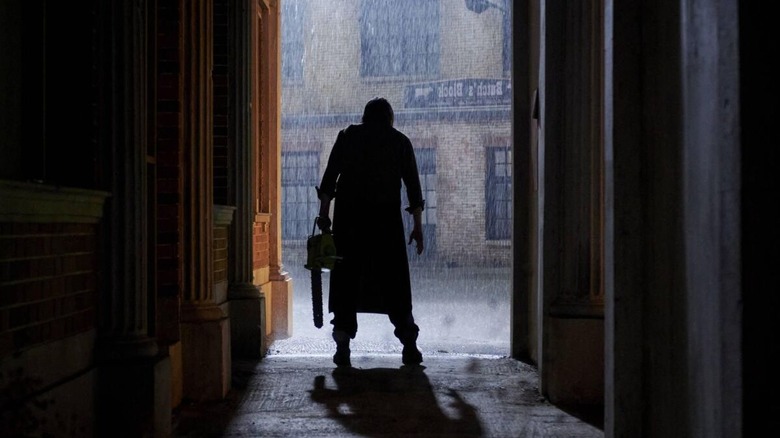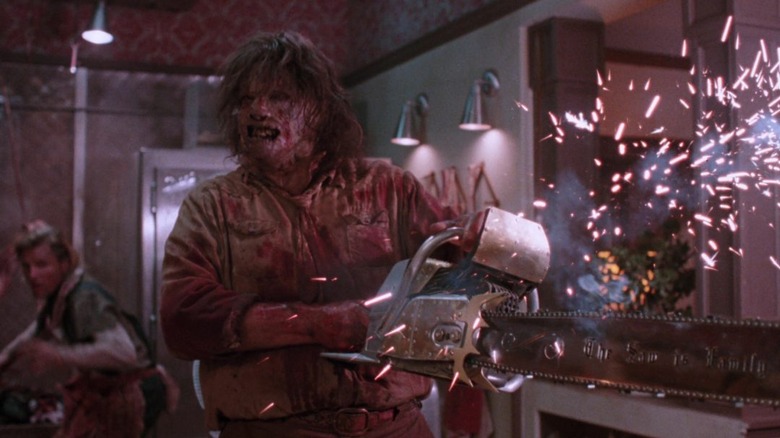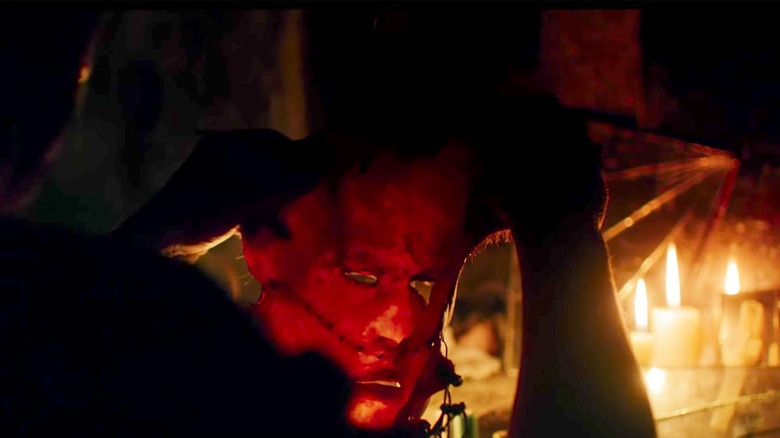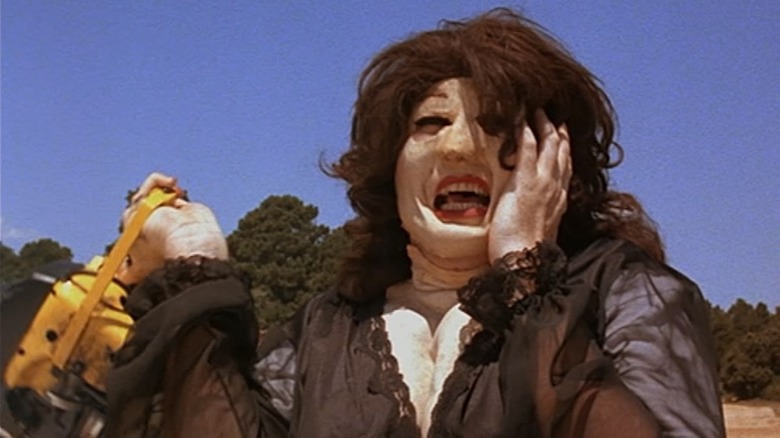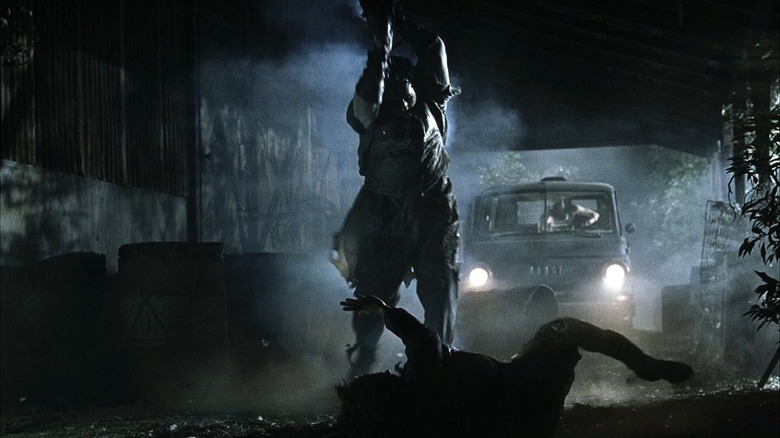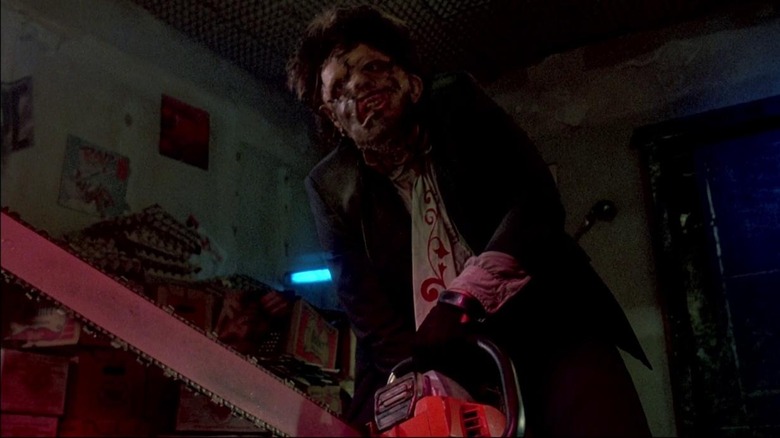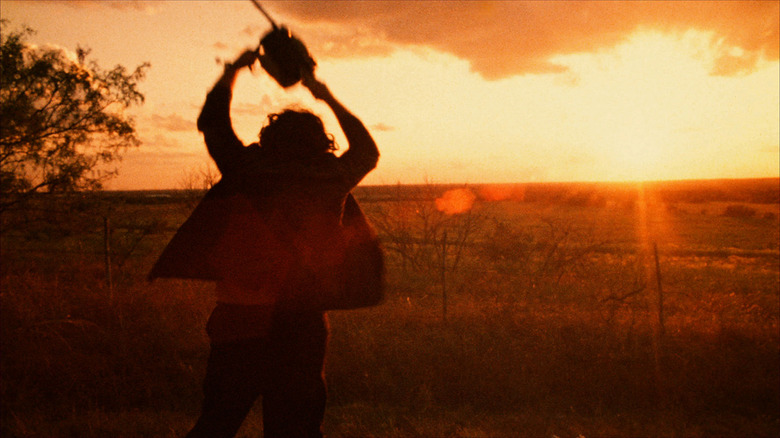Every Texas Chainsaw Massacre Movie Ranked Worst To Best
The Texas Chainsaw Massacre franchise has an identity crisis that goes deeper than interchangeable skin masks. To mainstream moviegoers in 1974, pleasantly removed from the sloppy-joe stylings of Herschell Gordon Lewis and his ilk, the standard of cinematic bloodletting sat with the black-and-white Bosco of "Night of the Living Dead" – even "The Exorcist" opted for less sacred bodily fluids. All it took to traumatize a generation was $140,000 and a bunch of Lone Star amateurs. "The Texas Chain Saw Massacre" gave terror a fresh shape and a pull starter.
And yet, the original film is not especially gruesome. Director Tobe Hooper consulted the Motion Picture Association of America constantly, even before heading to the editing room, in hopes of landing a PG rating. He failed, but the result is an optical illusion that lets the viewer see more than they're ever actually shown.
The film's immediate and lasting reputation as a grisly endurance test is only half deserved. Sequels compounded that misunderstanding by baptizing marquee maniac Leatherface in the slurry of his victims, alternately exaggerating and reducing him, rendering him the same as any other slasher icon. On account, the Texas Chainsaw franchise makes up for being shorter than any of its contemporaries by being weirder. Most of the continuations feel like remakes, with only the actual remake receiving a stylistically consistent follow-up, which happens to be the first of two prequels. The sum of all these false starts and failed do-overs is the most uniquely uneven series in the genre. Here's how they all carve up.
Honorable Mention: The Funhouse
Tobe Hooper's "The Funhouse" is a closer cousin to "Massacre" than most of the actual "Massacre" sequels and their impressionists. Looking to cash in on the craze he started, Universal enlisted Hooper to ordain their own low-budget slasher series. He thumbed his nose at that idea with a Carpenter riff in the first scene, then made something else entirely.
In "The Funhouse," the misfit family is on the defensive. All the carnies want is a moment of your time and the change from your soft pretzel. The carnival's gyrating attractions and fool's gold sparkle may be Vegas to the latest crop of teenagers, but to the barkers, it's home. So, when the meddling kids inevitably meddle and see something heinous, their terror carries a tinge of responsibility — that's what they get for gawking after the geek show.
Hooper had always wanted to do a "carnival movie" and his excitement glows on the screen like so much candy-colored fluorescence. Cinematographer Andrew Laszlo, fresh from "The Warriors," shoots it all in lavish anamorphic widescreen, flaring even the farthest bulbs into pink supernovas. But don't let the studio budget fool you — there's no mistaking the controlled hysteria of a hundred antique robots coming to life. Some swivel. Some rock in tiny chairs. Others claw with broken limbs at props long lost. The best one laughs, closing out the movie with the blackest punchline of all. Universal didn't get its hit, but at least Hooper got away with this.
9. The Texas Chainsaw Massacre: The Beginning
Everything wrong with this is right there in the trailer: "Witness the birth of fear." A not-inconsiderable part of the original's discomfort lies in its ragged ambiguity. How long has this family been at it? How have they never been caught? What's up with the big one?
"The Beginning" answers all that and more, but never quite justifies its own existence. Leatherface, adopted name Thomas Hewitt, draws first blood over a layoff. His chainsaw, horror's backwater Excalibur, is just what he steals on his last day.
This is as close as any "Massacre" gets to the clockwork doldrums of so many other slasher franchises, including the two "Massacres" explicitly designed to reinvent it as such. Threatened subtext, like the sheriff formerly known as Charlie Hewitt acquiring a taste for his fellow man as an abandoned POW, is just an excuse for R. Lee Ermey to play his hits. Even that committed performance, like everything else in "The Beginning," can't help but draw flies. Ermey gets the fatal line, when waxing historic about the cannibal clan's newfound might: "By God, they'll remember what we did." Easier said than done.
8. Texas Chainsaw 3D
For better and worse, it's much harder to forget "Texas Chainsaw 3D." The do-over sequel, easily the trend's most infamous, trips itself early by not just revisiting Tobe Hooper's 1974 original but revising it. There were several other Sawyers hanging out in that farmhouse and they all died in a Waco-inflected siege, save Leatherface and a baby immune to screams and small motors.
39 years later, that baby grows into 20-something Alexandra Daddario. That may be an infamously cheap shot — co-writer Adam Marcus explained that earlier drafts took place in the '90s – but it's only the most obvious of the film's many miscalculations. Those serial-killing, cannibalistic Sawyers are rebranded as misunderstood folk heroes. The shared blood between Daddario and her man-eating cousin, an obvious nature vs. nurture story, is instead played for Hallmark warmth. Not content with the earlier sequels' sympathy for the local devil, "Chainsaw 3D" expects nothing less than full support for his every slice.
In a post-mortem interview, Daddario recalled a producer defending the film's most notorious line, unwritten here for the sake of full shock and awe, with a shrug: "This is the movie." Anything goes in "3D." That is the movie, for better and worse.
7. Texas Chainsaw Massacre (2022)
There are three movies in 2022's "Texas Chainsaw Massacre." The first is a screed against the phone-fried Millennials who are gentrifying the world out from under the harder-working generations before them. The second is a deadpan parody of trauma-obsessed legacy sequels. The third is an update of the original's commentary on chaotic evil that mutilates in plain sight, the Vietnam subtext made mass-shooting text.
No two of those movies can comfortably co-exist, but director David Blue Garcia and writer Chris Thomas Devlin go for the hat trick anyway. Following the lead of "3D," all that matters here is the original film, but even that doesn't really apply. All that's actually important is the saw, and boy howdy does it still cut. And fly. And deflect shotgun pellets. And rev without running. And adorn souvenir tchotchkes at nearby gas stations. It's so hallowed that Leatherface keeps it sealed away at arm's length like John Wick's guns. To the film's credit, when the senior citizen finally busts out the Black & Decker, he puts it to good use; this is the first "Texas Chainsaw Massacre" with a genuine massacre in decades.
For both better and overwhelmingly worse, the film tries to be about more than the bloodshed, but every point goes moot in the crossfire. Surviving a school shooting becomes a superpower. An A+ gag with a self-driving Tesla is the punchline to 80 minutes of hating everyone who's in danger. But the series hasn't reached for any kind of meaning since Hooper and Henkel held the reins, and the ambition counts for something — a very thinly cut something.
6. Leatherface: The Texas Chainsaw Massacre III
After Tobe Hooper's own sequel failed to scare up box office results, New Line Cinema was obliged to adopt the Texas Chainsaw franchise. The aptly nicknamed "House That Freddy Built" intended to make a bonafide horror icon out of Leatherface, the kind that could profitably carve a new crop of wayward travelers to bits every other year. This is as far as they got.
Splatterpunk godfather David J. Schow wrote "Leatherface" as a follow-up to the original "Massacre," but director Jeff Burr insisted on an uncredited cameo from the sole survivor of "Massacre 2." This schism, further strained by one Sawyer's return, is a watershed moment — from here on out, continuity is only skin-deep.
The trouble with "Massacre III" is that it's not much deeper. The parts are novel — a sexually mature Leatherface, a survivalist who faces him, a cannibal family matriarch — but the sum is roadkill stitched back together minus the soft tissue. The film was submitted to the MPAA a staggering 11 times, with a few more teeth pulled each round. The Cuisinart-by-committee editing reduces what was advertised as "The Most Controversial Horror Movie Ever" to its own TV cut. The cast is a high-water mark for the franchise, especially "Dawn of the Dead" vet Ken Foree and an impossibly young Viggo Mortensen, but the only thing that gets slaughtered is the film itself.
5. Leatherface
This is a contentious placement without the proper curve. The enduring power of "The Texas Chain Saw Massacre" and its sequel, both conspicuously absent so far, is that neither played to preconceived notions. The first became one of the most infamous horror films in history by forcing the audience to imagine the worst parts. The second painted the worst parts Day-Glo and hung a "Kick Me" sign on them, taking the expected gore to its morbid extremity. As originally laid out by Hooper, points are awarded for swerves and surprises.
"Leatherface," to its fortune and foolishness, is built on them. Operating as a prequel to both the original "Massacre" and "3D," the story poses one of the most doomed questions in cinema: How did this icon become an icon? After being taken from the Sawyers as a child, young Leatherface grows up as well as can be expected in a reformatory. The catch, both to the audience and law enforcement, is that the program changes all names to distance troubled youth from their abusive families, making the escapees and the resulting murder spree a who-will-do-it-eventually mystery.
If the poster promised a "Massacre," that would make it a disappointment. Where "Leatherface" does inevitably falter is in its answer. Instead of building several likely suspects to take up the saw, there's an obvious choice and a twist that's only unexpected because it's so unbelievable. Compared to the Xeroxed thrills of the other late entries, that still counts for something.
4. Texas Chainsaw Massacre: The Next Generation
Three of the prime movers on the original "Massacre" got a chance to revisit their work. Of the resulting films, co-writer Kim Henkel's is far and away the most slippery.
"The Next Generation" ropes the first three "Massacres" into the same continuity. But the Sawyer family is now the Slaughter family, and Leatherface has regressed in both name and bloodlust to "Leather." Discrepancies should be taken as a warning — by Henkel's own defense, this is an Idea movie with a capital I. "All of the characters in the film," said the writer-director in a rare interview on the subject, "served as the various forces of authority and culture." On a personal scale, that means an exhibitionist real estate agent recommends implants to a pubescent Renee Zellweger. On a universal scale, that means that the literal Illuminati subsidize the farm for an ongoing experiment in trauma-induced transcendence. Squint too hard, and you may go cross-eyed when the businessman in charge of the operation unbuttons his Oxford to reveal three nipples on his stomach.
Henkel takes the bounced-check suspense of the original, never quite delivering on its ad campaign, and stretches it to bewildering, often unsatisfying extremes. Is Leather's newfound preference for a full, female skin suit meant to parallel the heroine's prom night journey into womanhood? Why would Matthew McConaughey, playing his own sound effects department, spray paint "ILLUMINATI" right onto his tow truck? Are the copy-paste murders part of an oppressive script that these unfortunate Texans are merely forced to re-enact, forever and ever, amen?
If Henkel knows, he isn't saying, but there's a valid reason the next "Massacre" was a remake.
3. The Texas Chainsaw Massacre (2003)
Freddy, Jason, and Michael Myers are easier targets for a revival; they'd already racked up more sequels and been refracted through more lenses than Leatherface. Yet, against all odds, he was first unto that breach. Against all odds, he did all right.
"The Texas Chainsaw Massacre," the power tool made compound, deals in a different kind of dread. It's too slick to play the same game — reframing the original as a movie based on these events is a savvy way to keep the legacy both handy and at arm's length. By trading the 16-millimeter uncanny for vividly gristled unpleasantness, "The Texas Chainsaw Massacre" stitches together a new identity. Finally, after the butchered "III," a "Massacre" makes good on its gore.
Original "Chain Saw" cinematographer Daniel Pearl is responsible for the movie's flash in more ways than one, convincing collaborator Marcus Nispel to direct and vowing to shoot it like an entirely different movie: "There's no point in making the exact same film with the exact same look." Pearl's second "Massacre" is almost monochrome, with amber waves of east Texas molding over after sundown. Blood, rust, and mildew all stain the same in the rechristened Hewitt house. Once again, Pearl's style, honed over decades of music video work, set a lasting standard for the visual language of horror. Some of the camera moves may be questionably acrobatic, like an infamous dolly through the head of a suicide victim to a tree across the road, but the septic sheen hasn't lost its edge — this is the "Massacre" that looks most like a massacre, and Leatherface has never been scarier.
2. The Texas Chainsaw Massacre 2
"'Chainsaw 2' was a reaction to the '80s," said Hooper, and how. The posters skewered John Hughes. The violence skewered competitors. The Sawyers skewered yuppies. "Massacre 2" skewered "Massacre," and its indelicate parody was paid for by Cannon Films, the production company that gave the decade its guns-and-gore stink in the first place.
The only overt holdovers from the original are actor Jim Siedow, two recurring corpses, and an occasional sense of cross-cut derangement, aroused most potently when Dennis Hopper tests a mile-long chainsaw to the shopkeeper's giggled delight. There's a familiar shallow-breath tension to it all, due no doubt to the film's seven-month turnaround from title page to premiere, but gasps come more often from "Three Stooges"-style schtick than scares.
In concept and courage, "Massacre 2" is a masterpiece, a cackling refusal to give the people what they want with a price tag that would've paid for its predecessor 33-times over. In execution, it's a sloppy bowl of blue-ribbon chili thrown at a wall that mostly, miraculously sticks. Hooper and "Paris, Texas" screenwriter L.M. Kit Carson take aim at everything from impotence to the plight of small business. If anything survives, there's certainly not much left of it.
1. The Texas Chain Saw Massacre (1974)
The fundamental unease of "The Texas Chain Saw Massacre" is best explained by the dueling thought processes of its writer and director. Kim Henkel researched homegrown serial killers like Ed Gein and Elmer Wayne Henley. Tobe Hooper wondered if there was a faster way to cut through department store crowds at Christmas time.
The opening crawl rings too true. The desecrated corpses in the first shot, straddling a gravestone like Halloween decorations, look too ripe. Immediately, effortlessly, "Massacre" threads the awful textures of waking life through the aberrant rhythm of nightmares. Before the weirdo hitchhiker does what weirdo hitchhikers do, he cuts his hand open like a magic trick. When Leatherface makes his grand entrance, it's on his schedule, seconds out of joint with any goosebumps that have been forecast. By the time a blood-sucking mummy wheels to the dinner table, it's as regular as Rockwell; just like unfortunate survivor Marilyn Burns, the audience doesn't have much sanity left to lose.
"The Texas Chain Saw Massacre" is alchemy. It was born wrong, the reckless work of amateurs who didn't know better, and got worse, leaving all the bodies and minds responsible for production with souvenir scars. A few years in either direction, technical limitations wouldn't have crippled it in the right way, and the culture wouldn't have taken turns banning and basking in it. The impact of its thrills, real and forcibly imagined, is so seismic that everything after could've only been a whimper by comparison. Seven sequels, prequels, and remakes later — not counting the one still to come — there's nothing quite like it. The blade still spins. The saw still smokes. Don't mess with "Texas," because it'll still mess with you.
